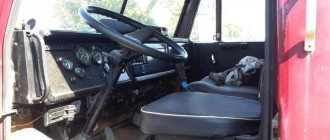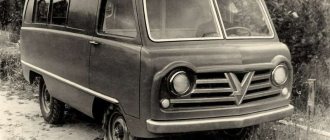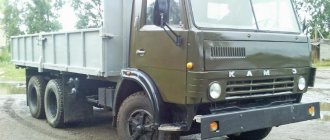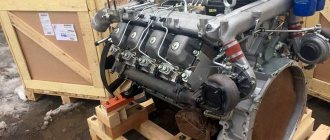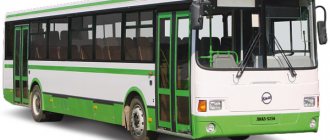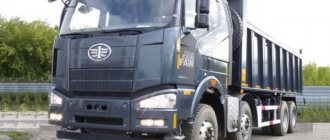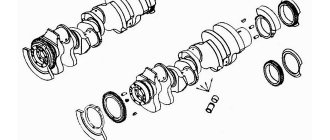Birth of a legend
In the 1960s, the Soviet Union experienced an acute shortage of trucks capable of carrying loads weighing more than 8 tons. At the same time, the development of cars of this class was already underway, but there was no production of suitable power in the country. In 1969, the government decided to build a new plant. Regions competed for the right to host the construction, because this meant a gigantic influx of funds and resources into the region for many years. As a result, Naberezhnye Chelny was chosen, at that time a small town in the Republic of Tatarstan. The choice of the city was influenced by its location in the center of the European part of the USSR, the proximity of railways and river routes. An important condition was the presence of the Nizhnekamsk hydroelectric power station, already under construction, near the city.
The enterprise has become a city-forming one. During the first five years of construction, the population of Naberezhnye Chelny grew sixfold: from 37 thousand to 231 thousand inhabitants. People from all over the Union came to the Komsomol shock construction site. In addition to the plant itself, housing, communications, infrastructure, hospitals, schools and much more were built.
It was truly a grandiose construction project. More than 2,000 contractors throughout the country carried out orders for the construction of the KAMAZ plant. 700 foreign companies provided their equipment and technologies. The enterprise's capacity was designed to produce 150 thousand trucks and 250 thousand engines per year. In 1973, the first stage of construction of the giant plant buildings was completed.
The main stages of development of the KAMAZ brand
The history of production of KAMAZ vehicles begins back in 1969. Economic growth in the Soviet Union dictated an increase in cargo transportation volumes. This was the reason for the emergence of a new enterprise that would produce spacious trucks with low fuel consumption.
Factory formation
The beginning of the KAMAZ history can be considered government decree No. 674, adopted in the summer of 1969, which stipulated the need to create a whole complex of automobile factories. Already on December 13 of the same year, construction of the enterprise in the city of Naberezhnye Chelny officially began.
The first KAMAZ models
The location of KAMAZ's future facilities (interpretation - "Kama complex of plants for the production of heavy-duty vehicles") was not chosen by chance. Its location in the center of the country, the proximity of railway lines and the Kama and Volga rivers provided transport links with major cities of the former USSR. More than 100 thousand workers were employed at the site. The largest domestic and foreign enterprises took part in the construction, providing the process with innovative equipment.
As the plant grew, so did the size of the city. In Naberezhnye Chelny, multi-apartment high-rise buildings, cultural and sports facilities were built, a tram line was launched, and an airport was opened.
Start of production
Today, the trademark called KAMAZ is a world-famous brand, the winner of numerous competitions and competitions, which is chosen by both Russian and foreign companies.
During the “arms race”, not a single foreign company agreed to cooperate with KAMAZ and sell its design developments. Therefore, the design of the first road giant was taken from the I. A. Likhachev Plant (abbreviation ZIL), which at that moment was developing vehicles for road trains. The progenitor of KAMAZ, to which it owes its origin, is the ZIL-2E170V truck tractor.
The release of the first car and engine became the most important stage in the history of the KAMAZ brand. The diesel engine was assembled in May 1974. A year and a half later, using temporary technology, the developers created a Soviet power unit with 210 hp. With.
KamAZ-5320
The first KAMAZ truck was released in February 1976. It was a three-axle 8-ton truck of the KamAZ-5320 brand. Decoding the numbers looks like this:
- 5 – car class;
- 3 – truck;
- 20 – model number.
The license plate of the first KAMAZ truck in history is 00-01 TAT. In subsequent years, several more car models appeared. By 1988, there were more than 10 names. The main ones:
- KAMAZ-5511 dump truck;
- truck tractors 5410 and 54112;
- onboard KAMAZ-53212 with an extended wheelbase;
- agricultural dump truck 55102;
- military KAMAZ-4310, which included a winch, a second fuel tank, and a tire inflation adjustment system.
The technical characteristics were impressive. Almost all models and their modifications had a powerful engine (220 hp) and a 10-speed gearbox.
In February 1983, it was decided to create a KAMAZ auto center that would service vehicles and also supply spare parts (middle, rear and front axles of long lengths, gearboxes, valves, springs, liners, dashboard elements, etc.). More than 200 centers across the country provided repairs to all KAMAZ models.
Production of small cars
1987 was marked by the opening of a new line that produced small cars called the VAZ-1111 Oka. The abbreviation VAZ stands for “Volzhsky Automobile Plant”. The model became an alternative to wheelchairs and was produced at 3 factories, including KAMAZ. Kamaz small cars were originally called “Kama”. "Oka" was a three-door hatchback-type car running on gasoline with a low-power engine in the simplest configuration.
Later, production was expanded, and ZMA KAMAZ was opened (stand for “Small Car Plant”), which in 2005 will become part of the Severstal Group. In 2006, production of Oka ceased. During this time, ZMA managed to produce more than 330 thousand small cars.
According to experts, such small dimensions of the Oka were both a design achievement and a mistake. Due to the shortened front and low weight, the car could hardly be called safe.
Factory fire in 1993
In the 1990s, imported goods, including trucks, poured into the domestic market. Because of this, the local auto industry suffered greatly. The situation at KAMAZ was significantly aggravated by a fire that occurred on April 14, 1993.
The fire started at the main step-down substation No. 12 in the main building of the engine plant. In a matter of minutes, due to gusty winds, the fire engulfed a vast area. The fire was localized only on the eighth day. Oil containers with a total volume of 1,700 tons were especially dangerous. The most difficult thing was to stop the fire in the basement.
It was one of the largest fires in history. To eliminate it, 64 units of fire equipment and 236 units of other devices and instruments were used. Thanks to active government assistance, the plant's work was resumed in December of the same year.
Brand development in the 2000s
By the early 2000s, the plant had significantly expanded its product range. Among them were dump trucks of various carrying capacities, long trucks, timber trucks, truck cranes, garbage trucks, grain trucks, and buses. Most models were produced with a KAMAZ-740.51 turbodiesel engine.
Subsequently, the plant began cooperation with foreign companies. The result was the manufacture of transmissions, brake systems and other elements. An important stage in the history of the KAMAZ brand was the agreement with Daimler Trucks, during which the technology for creating Axor cabs on air wheel suspension, intended for new generation vehicles, was obtained.
Today the plant is developing and implementing various innovations. Together with Innopolis University, the first drone with an aerial route reconnaissance complex was created. This car has been used in test mode since 2018.
In a couple of years, the plant plans to begin production of a small-tonnage car, a competitor to the popular Gazelle today. The KAMAZ brand on small wheels is currently designated by one word – “Compass”. However, the developers claim that the car's labeling will be adjusted.
"KAMAZ-Master"
The KAMAZ-Master racing team, a regular participant in the Paris-Dakar rally, achieved special achievements. It was created in 1988. The team first won the rally in 1996 and has since received the top award 16 more times. This is where the active promotion of the KAMAZ trademark began.
In 2016, the team presented a new racing KAMAZ in an unusual color. The traditional team color is blue, but this model was released in black, for which it was nicknamed the “Black Knight” by fans.
Today, the KAMAZ logo with the image of a horse is known throughout the world. In the modern world, branding is an integral part of any large company. Therefore, a team of the best designers developed a brand book indicating key elements, main colors, and equipment features.
“Take, Motherland, the first KAMAZ!”
With this slogan on board, the first production truck under the Kama Automobile Plant brand with model number 5320 rolled off the assembly line on February 16, 1976. There was a counter in the city that counted down the time until the release of KAMAZ. It was a real holiday for Naberezhnye Chelny and for the whole country. Today that first car is kept in the plant museum.
KAMAZ-5320 was produced with minimal changes until 2001, and it can still be found on the roads of Russia and neighboring countries. The KAMAZ-5320 cabin may seem spartan today, but then it was considered one of the most comfortable and safest in its class. Unpretentiousness in maintenance and affordable repairs have become the hallmark of KAMAZ. By the end of the 80s, the country was covered by a network of branded auto centers that carried out maintenance and supplied spare parts for trucks.
A little more than ten years after the production of the first car, the company celebrated its anniversary in 1988 - the production of the millionth truck. According to experts, in the first ten years of operation, KAMAZ fully justified all the funds invested in it.
Also in 1988, the KAMAZ-master racing team was created at the plant, which took on the mission of testing the reliability of trucks at international off-road rallies. Since then, the team's crews driving modernized KAMAZ trucks have become winners of the world's most prestigious rally, the Dakar, 16 times, and have also won the World Cup of Off-Road Rallies three times.
Despite the difficult situation in the 90s, when factories of the former USSR were closed one after another, KAMAZ remained in service and produced new models of trucks. In the 2000s, the company reached the global level and created joint productions with partners from the USA, Germany, India and other countries. Equipment exports in 2007 reached their maximum value at that time - 13,444 units per year.
How KamAZ appeared (Lots of PHOTOS)
On February 16, 1976, the first KamAZ truck rolled off the assembly line of the newly built Kama Automobile Plant. On its side was written: “Our labor gift to the XXV Congress of the CPSU.”
The terms of reference for the design of the experimental ZIL-170 implied the creation of 10 modifications of heavy-duty vehicles with a 6x4 wheel arrangement for operation as part of road trains weighing up to 26.5 tons and six all-wheel drive.
Having developed the ZIL-133 family of vehicles, the launch of which was delayed for various reasons, KEO ZIL in 1967 began work on a new promising family of ZIL-170 (6x4) and ZIL-175 (4x2) vehicles, similar in class to the ZIL-133. 133.
As a prototype, among those purchased abroad for testing and identifying the required class of hooded and hoodless analogues, the choice of the chief designer of ZiL trucks, Anatoly Mavrikievich Krieger, fell on the American “International” series 220.
International COF-220 (1962-1966).
It is possible that when choosing a sample, the fact that Krieger was already familiar with trucks from working on the ZiS-150 also played a role.
Cabover layout with a comfortable cabin; powerful diesel engine; pneumohydraulic booster in the clutch drive; 5-speed synchromesh gearbox with front splitter converting it into a 10-speed unit; multi-circuit pneumatic braking system; lockable center differential; power steering; the ability to work as part of a road train - qualities of the new truck that made it possible to take a revolutionary step in the production of Soviet trucks.
In the ZIL version, the cabin acquired slightly different, more rectangular shapes and an elegant front end, with the air intake grille on the right side that is so familiar to us. ZIL-175
ZIL-170 at VDNH 1969.
Already in May 1969, the first prototype of the ZIL-170 vehicle passed its first tests on the Uglich-Rybinsk section.
For a quarter of a century, the design and construction of cars have hardly changed...
ZIL-170
But the ZIL-170 was never mass-produced at its native plant.
By the mid-60s of the last century, there was an acute shortage of trucks in the USSR, especially those with a carrying capacity of more than 8 tons. Cargo turnover within the Soviet Union was growing, and none of the country's existing automobile factories was ready to start producing such cars. Completely new trucks were required. Most of the vehicles (the bulk of the cargo fleet were medium-duty vehicles) had long expired. There is an urgent need for equipment with greater carrying capacity, road trains for long-distance transportation of bulk cargo and heavy dump trucks. The directives of the XXIV Congress of the CPSU stated: “It is required to create a complex of automobile factories for the production of trucks in the Tatar Autonomous Soviet Socialist Republic and related enterprises in the surrounding areas...”
In mid-1969, a Decree was adopted by the Central Committee of the CPSU and the Council of Ministers of the USSR on the construction of a complex of factories for the production of heavy-duty vehicles in Naberezhnye Chelny. The city, due to its geographical location (proximity of the railway and other factors), was suitable as a place for a future automobile plant. In addition, the Kamgesenergostroy organization would cope with both the construction of a dam and a 1.5 million-kilowatt hydroelectric power station, as well as the construction of factory buildings and housing.
The construction of KamAZ turned out to be the last “All-Union Komsomol shock construction project”, which was successfully completed, and much earlier than planned.
A prototype of the KamAZ-5320 (ZIL-170) truck with a sleeper cab being tested.
A factory-assembled KamAZ undergoing testing.
After construction, the documentation for the new truck, familiar to us as KamAZ, was transferred to the new Kama Automobile Plant.
In May 1974, the first engine was assembled at KamAZ in the experimental workshop of the chief designer's management, and conveyor production on its own, but still using temporary technology, began in December 1975. The first 5 KamAZ-5320 trucks rolled off the main assembly line, which was still only in commissioning mode, on February 16, 1976. According to the tradition of those years, the trucks from the first batch were decorated with the slogan “Our labor gift to the XXV Congress of the CPSU.”
KamAZ-5320 No. 1.
While the KamAZ team continued to assemble cars on the main conveyor in the adjustment mode from parts obtained during the commissioning of technological equipment, the government approved the general scheme for managing the automotive industry. According to this scheme, the Kama Automobile Plant received the status of a production association and began to report directly to the USSR Ministry of Automotive Industry, bypassing all central departments. On December 29, 1976, the State Commission headed by the Minister of Automotive Industry of the USSR V.N. Polyakov signed an act on the commissioning of the first stage of the Kama complex of factories for the production of heavy trucks. By the end of 1976, 5,000 vehicles were produced, including the KamAZ-5320, its modifications and the KamAZ-5410 truck tractor. Production of the chassis for the KamAZ-5511 dump truck began in 1977. All these models had a similar design and were largely unified.
KamAZ model range:
large-capacity 5410, 5411, 5415, 5425, 5320, 5321, 5360, 5510, 5511, 4310, 4311, 6511
bonnet 4355
medium-duty 4911, 4925
There are overseas production facilities in the following countries:
- Kazakhstan.
- India.
- Azerbaijan.
- Ukraine.
- Ethiopia.
- Vietnam.
- Pakistan (since November 19, 2006).
- Iran.
- DPRK.
- Poland.
This is how the “people's” KamAZ appeared.
PS For some reason there is no mention of the ZIL-170 on the official KamAZ websites: https://kamaz.net/ru/company/history/ https://www.kamaz-rba.ru/company https://www.ackamaz. ru/about/
https://www.liveinternet.ru/users/pekshin
Not just trucks
KAMAZ is known not only for producing trucks under its own brand. Since 2000, the Neftekamsk Automobile Plant, a subsidiary of KAMAZ, has been producing NEFAZ city buses, which today can be seen in many Russian cities.
Currently, KAMAZ produces electric buses developed jointly with Russian engineers from Drive Electro. Electric buses are superior to traditional public transport in terms of noise, environmental friendliness and efficiency. Today, 30 electric buses produced by KAMAZ are running around Moscow, and new eco-friendly vehicles and charging stations are expected to be delivered in the near future.
Another promising project that began testing in 2015 is the development of an unmanned vehicle. Already in 2016, KAMAZ, together with the NAMI scientific institute, presented the concept of the Shuttle project, small unmanned buses for the city. The first drones within the project were tested in limited areas: universities, science cities, and exhibition complexes. Meanwhile, the government is working on regulating driverless vehicle legislation.
K5 is the most anticipated new product of the year
For its 50th anniversary, KAMAZ is preparing a unique gift - the launch into mass production of the first KAMAZ-54901 tractor from the new K5 family. The K5 generation cars mark the company's entry into the premium segment. The first pre-production tractor is already being run-in and tested.
The new model features improved ergonomics, modern components and assemblies. Particular attention is paid to the cabin, which is made to all the latest standards of safety and comfort. The K5 family will be equipped with an inline 6-cylinder P6 engine with power ranging from 380 to 550 hp. and a resource of 1.5 million km, which corresponds to the best world analogues of this class.
Modernization of production, creation of a new model range, entry into world markets - all this would be impossible without investment. In 2022, as part of a joint investment project, the Rostec State Corporation allocated 5.5 billion rubles to KAMAZ.
KAMAZ is approaching its half-century anniversary as the largest Russian manufacturer of heavy trucks, which corresponds to all modern trends. This includes the digitalization of production, the development of eco-transport, and the development of drones. KAMAZ is regaining its status as a city-forming enterprise, increasingly influencing the social sphere of Naberezhnye Chelny. The changes in recent years at KAMAZ have laid a powerful basis for the further successful development of the enterprise.
How the first Soviet KamAZ truck was created - KamAZ-5320
The Kamaz-5320 is one of the most recognizable heavy trucks of the USSR. This vehicle had a 6x4 wheel arrangement and was capable of carrying 8 tons of cargo. In addition, it could transport a trailer with a load of 8 tons. Thus, the total weight of cargo transported by KamAZ reached 16 tons, which was a real record for those years. The very first flatbed KamAZ-5320 rolled off the assembly line in 1976 and was produced without significant changes until 2001. A plant was built on the banks of the Kama River specifically for the production of the new truck. The car received an all-metal body with opening sides and an awning. The KamAZ-5320 cabin was designed for 3 seats and was equipped with points for attaching seat belts. The power steering KamAZ-5320 was also quite revolutionary. Thanks to the power steering design, which could adjust the steering force in accordance with the level of resistance to turning the wheels, the driver could literally “feel” the road. The KamAZ-5320 device had a rather revolutionary appearance for those years. Suffice it to recall the cabin, which lacks a hood space in the front. Although MAZ trucks already had a similar layout, KamAZ’s appearance was more modern. The history of the appearance of the first KamAZ car
The history of the first KamAZ began at the Likhachev plant (ZIL). It was there that the KamAZ-5320 prototype was developed, which was then called ZIL-170. The first ZIL-170 was assembled in 1968. The motor chosen from the Yaroslavl Motor Plant, known as YaMZ, was chosen as the engine. Since the new car was supposed to have a completely new design, the Canadian International COF-220 truck, model 1962, was chosen as the experimental model on the basis of which the prototype was to be created. A Soviet car was not supposed to externally copy a “bourgeois” car, so several changes were made to the cab design scheme: The truck’s cab received a straighter shape, in accordance with the fashion of the time; An air intake grille was installed at the front of the car; The Soviet truck also received 4 headlights (two double headlights on each side)
In 1969, the new ZIL-170 passed tests, and ZIL designers were preparing to launch it into mass production, but then the “party” intervened, which considered that the new car should be produced at a new plant. The resolution of the CPSU Central Committee and the Council of Ministers stated that further development and production of the ZIL-170 was transferred to the plant in Naberezhnye Chelny.
Since the KamAZ plant could not produce ZIL, the new truck was renamed KamAZ-5320. It was very difficult to quickly set up production at the new plant, so the first prototype of the KamAZ-5320 rolled off the assembly line only in 1974. Serial production was established after 2 years, and on February 16, 1976, the first serial heavy-duty KamAZ-5320 trucks solemnly rolled off the plant’s assembly line. There was a beautiful legend among the people that the YaMZ engine, which was installed on the prototype ZIL-170, was too weak. That is why the engine was chosen for the KamAZ-5320, which was installed on the new T-64 tank. In fact, the tank engine, which was two-stroke and opposed, had nothing to do with the KamAZ engine. This legend was invented by plant managers in order to somehow justify the long development of an essentially finished truck.
Brief technical characteristics of KamAZ-5320 and models produced on its basis
The layout of the KamAZ-5320 was similar to the layout of MAZ vehicles of those years of production. The cabin was a 3-seater cabin, although only 2 people could fit there with relative comfort. To access the car's engine, it was necessary to tilt the cab forward. This procedure was carried out using a special torsion mechanism. The engine, KamAZ-5320 gearbox and clutch were assembled in one unit, which was located on special supports. KamAZ-5320 was the first “swallow” in the family of heavy-duty vehicles. The same scheme was used for their production. Soon several more models were created on its basis:
—Powerful truck tractor KamAZ-5410;
—Flatbed truck on an extended KamAZ-53212 chassis;
—KamAZ-5511 mining dump truck. This vehicle could carry up to 10 tons of cargo, since its axle load was significantly increased;
—KAMAZ-53213, which was a chassis for installing various equipment;
—A whole family of biaxial models. For example, 5325, 4325, 43255 and 4410.
All these models, even biaxial ones, had a unified design.
Power units and transmission installed on KamAZ-5320 and other models
For all KamAZ vehicles created on the basis of 5320, a diesel engine from the Yaroslavl Motor Plant YaMZ was used. The use of a diesel engine allowed the truck to carry more weight. The diesel engines that were used in KamAZ trucks used the most advanced schemes at that time in their work. For example, the full flow centrifuge oil filtration system design was not used on any truck of the time. The YaMZ engine is four-stroke I-shaped, has 8 cylinders and a working volume of 10.85 liters. Its power was 210 or 180 l/s, depending on the modification. Compared to gasoline engines, diesel engines had excellent traction, both at low and high speeds. The modern cooling system did not provide for the presence of water in it, since Antifreeze was poured into it, which was also quite unusual for cars of that time. Thanks to the use of a new diesel engine, it was possible to significantly reduce fuel consumption. For KamAZ-5320, the average fuel consumption rate is 34 liters per 100 km, which is significantly less than gasoline trucks of those years, which also did not have such a carrying capacity.
The KamAZ-5320 clutch was also revolutionary. The operating diagram of the KamAZ-5320 double-disc clutch used a pneumatic booster, which made it easier for the driver to press the pedal. During operation, it may be necessary to adjust the KamAZ-5320 clutch. Maintenance of the KamAZ-5320 clutch consists of checking the pedal travel, free play of the release clutch and the pneumatic booster pusher. Having adjusted all these components, the process of adjusting the KamAZ-5320 clutch can be considered complete. The KamAZ-5320 has a five-speed gearbox. Since KamAZ tractors have 10 gears, some believe that the KamAZ-5320 was equipped with 2 types of gearboxes, 5 and 10 speeds. In fact, this is one gearbox, it’s just that in tractors it is equipped with a special gearbox-divider, which increases the number of gears by dividing them. The KamAZ-5320 gearbox is controlled by a mechanical drive.
Brake system KamAZ-5320
Since the KamAZ-5320 was one of the heaviest trucks of its time, the design of its braking system was somewhat different from the braking systems of other Soviet trucks. KamAZ has several brake systems: Standard service brake system, which consists of drum-type brake mechanisms with two shoes on each wheel of the vehicle. The drive of the working system is double-circuit pneumatic, with separate action on the wheels of the front axle and the rear bogie; The parking brake system holds the car by braking the rear wheels. When the parking brake is applied, the brake mechanisms are activated by spring energy accumulators. The auxiliary braking system operates on a completely different principle. Its mechanisms are located in the muffler pipes. If the auxiliary brake system is activated, its mechanisms use special plugs to block the inlet sections in the gas exhaust system; The spare parking brake is used in the event of an emergency failure of one of the vehicle's braking systems. To engage it, you need to use the parking brake, so the secondary parking brake is activated along with the main one. In order to avoid problems with the brake system, it requires constant maintenance and periodic diagnostics. Since brakes must work flawlessly to hold a multi-ton vehicle, servicing all brake systems is a mandatory periodic procedure.
Maintenance and repair of KamAZ-5320
Although many modern drivers, especially those who do not work on their own trucks, consider daily visual diagnostics unnecessary, this procedure can save the driver's life. In addition to daily self-inspections and checks of technical fluid levels, it is advisable to check KamAZ at a service station every 10,000 km. KamAZ-5320 bridges deserve special attention. It is necessary to ensure that the fastenings are not loose, and to monitor the oil level in the gearboxes of the KamAZ-5320 axles. Such in-depth diagnostics are necessary, since in the event of a sudden failure of one of the systems on the road, an uncontrollable vehicle with a heavy load will pose a mortal danger to all road users. KamAZ 5320 power steering, steering wheel and cabin, engine structure and power steering circuit, maintenance and technical characteristics... Maintenance of the KamAZ-5320 also includes checking all the electrics that were installed on the KamAZ-5320. All suspension and braking system components are checked. If it is found to have unacceptable wear, it must be replaced with a new one. Currently, there are still many KamAZ-5320 trucks and its modifications found on the roads of Russia and the CIS. These trucks, despite their age, are popular due to their ease of repair, inexpensive maintenance and low cost of spare parts.
Source

